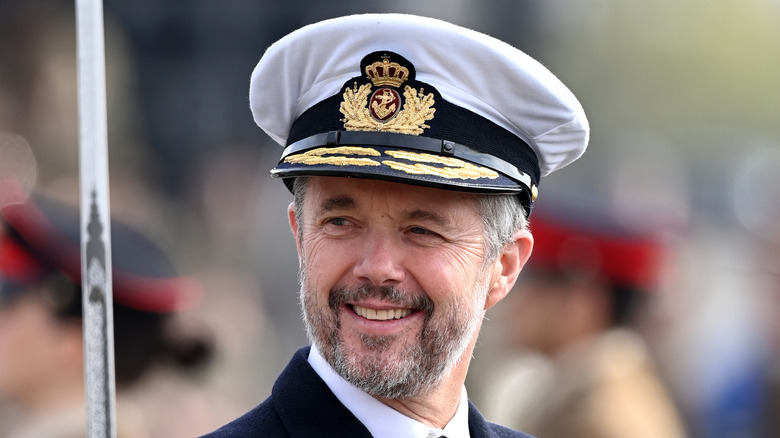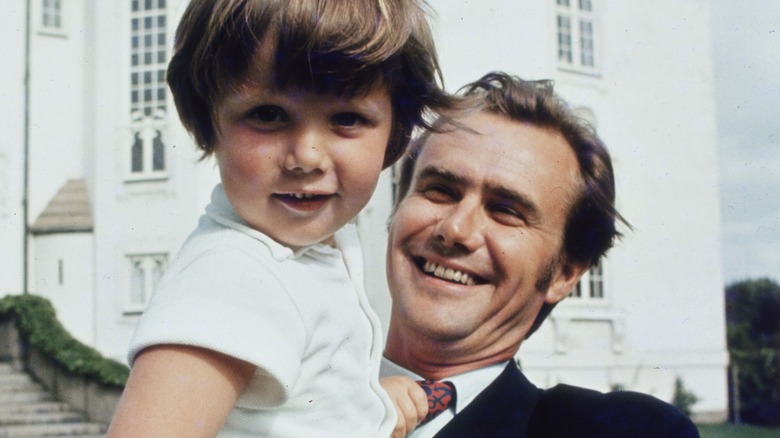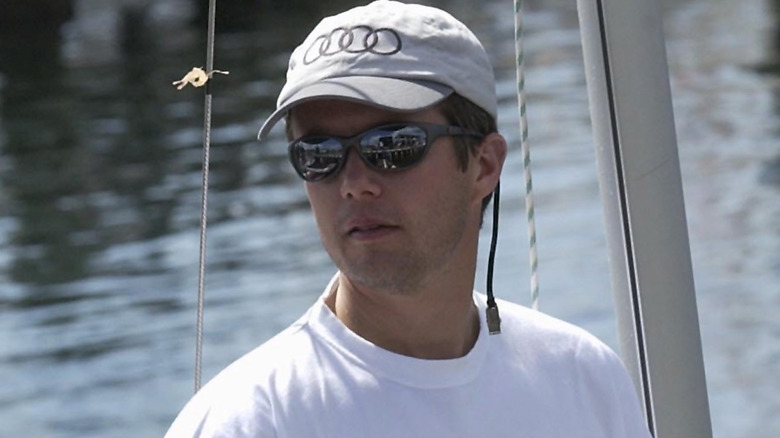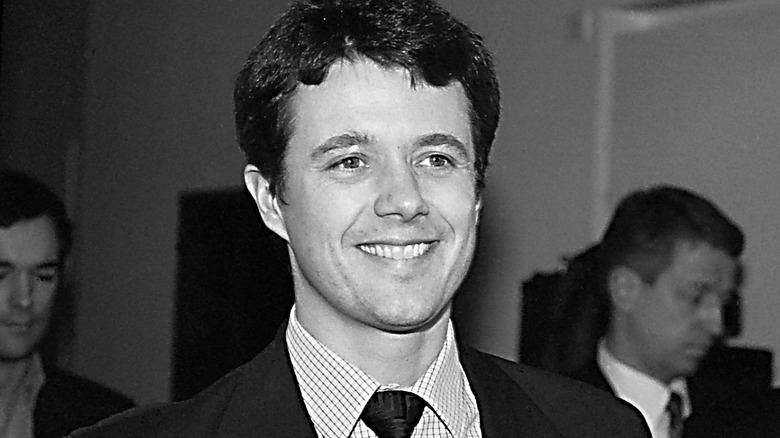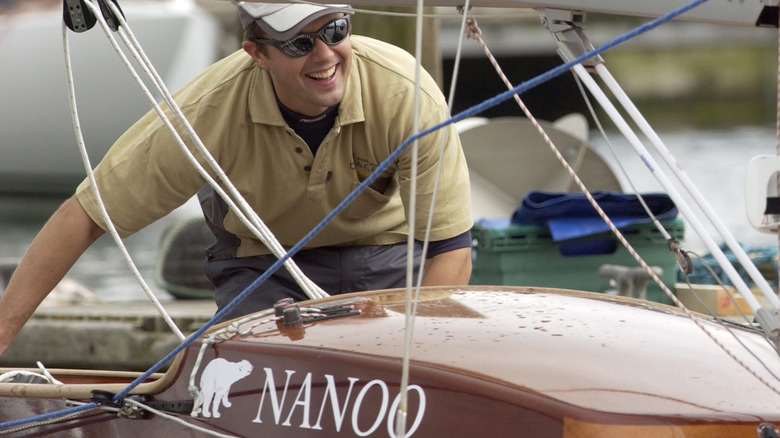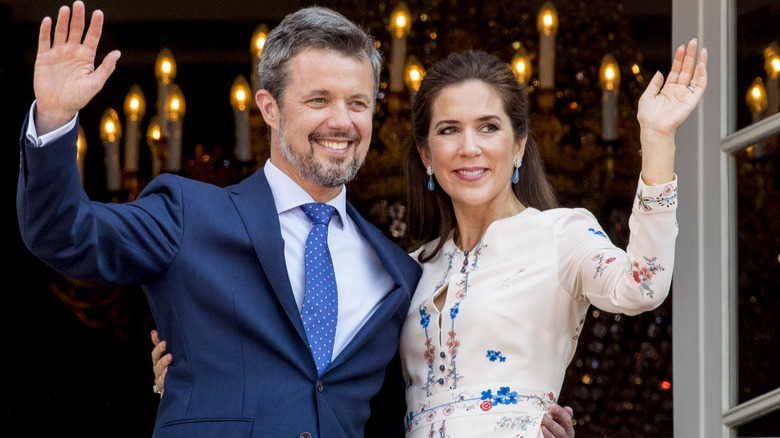Who Is Crown Prince Frederik Of Denmark?
The 20th century was not kind to monarchies. World wars, revolutions, referendums, and forced abdications toppled crowns from China to Portugal. But in Europe, pockets of royalty lingered as the ceremonial component in parliamentary democracies. Among the countries that have retained their crowned heads of state into the 21st century is Denmark, where the House of Glücksborg has reigned since 1863, per The Royal House (Kongehuset in Danish). For the past 52 years, the Danish throne has been held by Margrethe II, who has not only been queen for all that time, but also an internationally recognized illustrator and designer who contributed to film, ballet, and the Danish edition of "The Lord of the Rings" (per The Hollywood Reporter).
Less constrained by court etiquette — and less pilloried by the press — than her more famous British counterparts, Margrethe was considered an accessible monarch. According to Vogue, her bold design choices and occasionally stern and direct addresses to the Danish people only strengthened her popularity. It came as a great shock to most Danes when, in December 2023, their queen announced her intent to abdicate the following January, citing her declining health (per The Guardian). The throne would pass to her eldest son, the Crown Prince Frederik.
For Danes, the crown prince was already a familiar and popular figure, one with a lot of goodwill from his people despite sadness at his mother's departure. International observers grew curious about this 55-year-old king-in-waiting. Here is the story of Frederik's life and career as crown prince.
Frederik once doubted that he wanted to inherit the throne
Though the House of Glücksborg has held the Danish throne for less than 200 years, Denmark's Ministry of Foreign Affairs boasts that the country's royal family is Europe's oldest, tracing the ancestry of its reigning family to Gorm the Old of the 10th century. It was to that legacy that Crown Prince Frederik was born on May 26, 1968. At the time, his mother was still Princess Margrethe, four years away from her accession. He and his younger brother Joachim were educated in private schools in Denmark and later studied at the Écoles des Roches in Normandy at the urging of their father, Prince Henrik, originally a Frenchman (per The Royal House). Growing up, Frederik was heavily influenced by one of his principals, Jørgen Stegelmann, and his maternal grandmother, Queen Ingrid of Sweden.
Despite the wishes of Margrethe and Henrik that their children have something close to a normal childhood, the duties of even a ceremonial head of state are demanding, and The Guardian reported that Frederik felt his parents put him second to royal duty. His resentment against the crown intensified in his early adulthood as he struggled with the reality that his future career was already prescribed. "I felt as if a blanket had been thrown over me, something which limited my opportunities and my desire to explore the world," he once said (via the Ministry of Foreign Affairs). For a time, he doubted both his enthusiasm and his fitness for kingship.
He was known as Denmark's party prince in his youth
In the face of parental neglect and the looming responsibility of the Danish throne, a young Crown Prince Frederik responded by acting out. Danish royal expert Gitte Redder told Agence France-Presse (via The Guardian) that he couldn't quite be called a "rebel," but he indulged in easy vices of the rich and famous, particularly fast cars. His high living as a teen and young adult earned him the moniker "party prince."
The media culture of Denmark in the 20th century was not as driven by the tabloid press as Britain's, and Denmark's monarchy is low-key by royal standards, so Frederik's youthful escapades didn't become the stuff of hot international gossip. "Spoiled" is the worst adjective attached to Frederik in retrospective looks at this time in his life, and he doesn't seem to have impacted the popularity of the Danish monarchy the way the disasters of younger British royals dented (however modestly) the House of Windsor. Then again, Frederik's period of relatively wild behavior was short-lived — by his mid-20s, Redder told AFP he had already begun to overcome his insecurities about his upbringing and destiny.
He was the first Danish royal to complete a university education
When he turned 18 in 1986, Crown Prince Frederik automatically became part of the Council of State, Denmark's privy governmental body responsible for granting royal assent to legislation passed in Parliament (Folketing). Eighteen also marked the beginning of Frederik's military training. He was trained in all three branches of the Danish military, obtaining the rank of commander in the navy and major in the army and air force. Fredrik was one of just four applicants (out of 300) accepted into the Naval Diving Corps during his military education. According to The Independent, while training for the corps, he picked up the nickname Pingo when his wetsuit filled up and left him waddling like a penguin.
As the heir apparent, a necessary part of Frederik's education was political science. Wanting a thorough understanding of the subject, he opted to major in it at Aarhus University, with a year at Harvard (he would later establish a fund for other Danes wanting to study there). Asked once why he pursued his education past his required studies, Frederik answered (via the Ministry of Foreign Affairs), "I do not want to be helped to anything. I want to test my own strength." In line with that attitude, his personal motto is said to be "learning through trial."
Frederik graduated with a master's in political science in 1995, the first Danish royal to complete a university education (per The Guardian). Besides his military and political studies, he's also studied viniculture, English, French, and German. He and his brother Joachim also studied French history while at the Écoles des Roches.
He's known for his sportsmanship and environmentalism
Since completing his education, Crown Prince Frederik has been a working member of Denmark's royal family, acting as patron for various institutions, participating in state events, and promoting the nation's achievements. Before Queen Margrethe II's abdication announcement, Frederik's share of duties had been on the rise because of his mother's declining health (per Sky News). A particular focus for him is the environment, having developed an interest in the matter while completing his degree (via The Telegraph). Denmark's playing host to COP-15 in 2009 strengthened his commitment, and his patronages include Danish environmental groups and international prizes. Per The Royal House (Norway), Frederik, Crown Prince Haakon of Norway, and Crown Princess Victoria of Sweden undertook an expedition to Greenland to study the effects of climate change on polar regions and later published a book on their experience.
Frederik was part of a less solemn visit to Greenland when he signed up as a driver for the Sirius 2000 expedition, broadcast via multiple documentaries. He also gets plenty of exposure to the outdoors as a boat racer. Per Sail-World, Frederik finished fourth in the 2003 European Championships for dragon boat sailing. Sports are among the activities he's best known for in Denmark, and the Ministry of Foreign Affairs even acknowledged his temperamental competitive streak. He's presumably less intense during the Royal Run, an annual running event where he and other royal family members mingle with Danes of all ages and experience levels.
His wife is a Scottish-Australian
In 2000, while visiting Sydney, Australia during the Olympics, Crown Prince Frederik stepped into a local pub and met Mary Donaldson, the Tasmanian-born daughter of two Scottish emigres (per CNN and The Telegraph). Twenty-eight at the time (Frederik was 32), Donaldson had no idea that the man she met was royalty, or anyone of note — she was only told an hour after the encounter. But romance soon followed, with Frederik making secret rendezvous to the land down under. When their relationship finally became public, Denmark was delighted. The couple married on May 14, 2004, and they have four children.
Foreign-born spouses of royalty have struggled to gain acceptance throughout European history, but Crown Princess Mary, as she is now known in Denmark, has become as popular as her husband with Danes. Her concerted effort to learn Danish earned her a considerable amount of goodwill, and her and Frederik's visibility at concerts and sporting events has helped to further endear them to the nation. Historian Sebastian Olden-Jørgensen described them to AFP (via Yahoo News) as "modern [and] woke," and a natural continuation of the Danish monarchy's transition into the 21st century.
Some foreign press outlets speculated that Queen Margrethe II's abdication was influenced by her son's marriage. The Telegraph quoted Danish royal commentator Phil Dampier as speculating that Margrethe was worried about rumors that Frederik was having an affair with Mexican socialite Genoveva Casanova. These rumors broke a few months before the abdication announcement. But other royal watchers didn't share Dampier's theory, and Casanova strongly denied the rumors.
